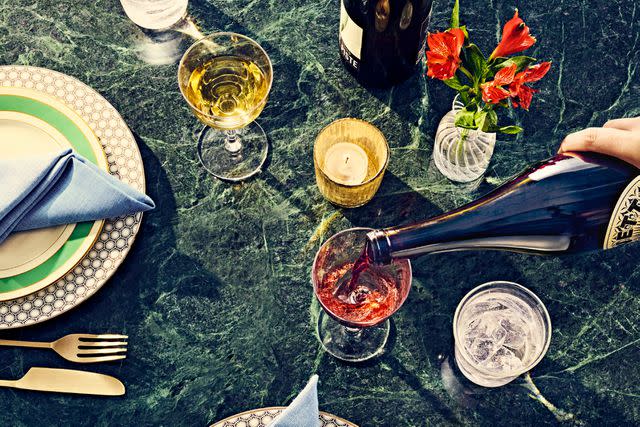How to Order Wine in a Restaurant
A sommelier shares how to make sure you get a wine you like, without breaking the bank or embarrassing yourself in the process.
You know that mild panic you get when you look over a wine list and don’t see anything familiar? Or that awkward moment when you try a glass and it’s way too dry, or you think it’s corked but aren’t sure? I don't love any of this for you! So, I asked a top sommelier about picking and sipping wine at restaurants. Tamy Rofe oversees all things drinking at the two dining hot spots and catering company she co-owns in New York City. In total, her wine lists include 250 bottles. These are the questions I hear the most—and Rofe’s helpful answers.

Ted + Chelsea Cavanaugh
Will I be disappointed if I just order the cheapest bottle?
It depends on whether wine is a priority for the restaurant, Rofe says. An easy way to find out is to look at the list of wines by the glass. “If only the grape is mentioned and not the producer, that’s a red flag,” she explains. If you’re at a restaurant where wine is taken seriously, go ahead and order the least expensive option. “As a sommelier, I want to prove that wine can be incredible no matter the price,” Rofe says. At a restaurant where wine isn’t at the heart of the experience, the least expensive may be low-quality, so proceed with caution.
If I’m ordering wine for the table and I want suggestions from the server, how can I discreetly communicate my budget?
Give the server a rough idea of the type of wine you’re looking for, like a fruity red or a white that pairs well with seafood, and ask for a couple of options. “Trained staff will always suggest bottles at different price points, and you can make your choice from there,” Rofe says. You can also point to a bottle with a price around what you’d like to spend and say to the server, “We’re thinking of something in this area.” Another option: Just tell your server your desired price range. Let’s normalize talking about money, shall we? You work hard for it, after all!
What’s the best way to navigate a long wine list?
Start by narrowing down what you want among the group at your table, Rofe says. Just landing on color and body helps. Do you want a red or a white? Lighter or heavier? Then enlist your server. “There are probably winners or standouts in the staff’s mind. Say something like ‘Hey, this is a long list. Are there any you love?’ And let your server know if you decided on red or white, full-bodied or lighter.”
When the server pours me a bit of wine to taste, do I need to swirl and sniff?
Yes! “Swirling the glass activates the wine,” Rofe says. “Remember, it has been stuck in a bottle, sometimes for years! It needs to be woken up. Then you need to go in for a deep smell.” That whiff is to make sure the wine is in good shape. If it smells metallic, plain old bad, or like nothing at all, it might be corked, meaning tainted by a bacteria from the cork. Assuming it passes the smell test, then you taste it. Don’t worry about feeling like an impostor—no one is judging you, and the whole process really just benefits you.
What if I don’t like it? Can I get a different wine?
If you think the wine is corked or off, ask the server to taste it. If they agree, they’ll give you a new pour. If you just don’t like it, rules vary based on whether you ordered by the glass or the bottle. If you ordered by the glass, absolutely ask to try something else. (Bonus tip: When you order by the glass, ask for a taste first!) “Try to explain why you don’t like it and what you’re looking for instead,” Rofe suggests. If you ordered by the bottle and dislike it, the situation gets trickier. Officially, as long as the wine isn’t spoiled, you’re stuck with it. “But I still recommend letting your server know,” Rofe says. “You could say something like ‘This wine isn’t bad, but it isn’t to our taste. What do you recommend?’ At many restaurants, they’ll figure out a way to make you happy without having you buy a whole new bottle.” (If they make things awkward, you may choose not to go to that restaurant again.) Also, remember that even if you don’t like a wine at first, the flavors and aromas often develop and deepen once it has been in the glass for a few minutes. You might like it better on the second sip, or with food.
For more Real Simple news, make sure to sign up for our newsletter!
Read the original article on Real Simple.








